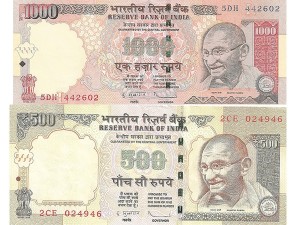 To find a way out of the massive cash crunch prevailing in the country in the wake of demonetisaion of Rs 500 and Rs 1000 notes, the Finance Ministry is planning to use indelible ink at the banks to mark those who have exchanged new notes to ensure that people do not draw more than the allowed limit.
To find a way out of the massive cash crunch prevailing in the country in the wake of demonetisaion of Rs 500 and Rs 1000 notes, the Finance Ministry is planning to use indelible ink at the banks to mark those who have exchanged new notes to ensure that people do not draw more than the allowed limit.
This is the same tactics used for several years in India during elections to prevent multiple voting .
An ink stamp will be used after a person has exchanged Rs 4,500 worth of old notes for new ones, the weekly limit set for now.
“Some unscrupulous people are trying to convert their black money into white and have arranged for groups and are sending them from one branch to another to exchange notes. So you see, the same people are coming again and again,” said Economic Affairs Secretary Shaktikanta Das.
On November 8, Prime Minister Narendra Modi announced that Rs 500 and Rs 1,000 notes were being withdrawn from circulation to combat black money and corruption. They have been replaced with new high-denomination notes for Rs 500 and Rs 2,000.
Since the announcement, the bank branches and ATMs have been flooded with people to withdraw the new currency. Modi has urged the country to give him “just 50 days” to clean up the system and “bear with inconveniences” because the move will ultimately benefit the poor.
The Finance Ministry officials said the people having black money are harassing the poor with “Jan Dhan” bank accounts and forcing them to deposit the old notes in their accounts, which would effectively convert them into white or legit cash. These accounts, which have a limit of Rs 50,000, provide users, especially in rural areas, with a debit card, overdraft facility and accident insurance cover for up to a lakh.
There have been a series of media reports on how the deposits in these accounts have shot up since the notes ban was announced, with some suggesting that those with black money were using them to turn in old notes that they cannot account for against their declared sources of income. “Legitimate deposits will not be put to any inconvenience,” said the Economic Affairs Secretary.
To ease the pressure and reduce inconveniences, the government has increased the weekly cash withdrawal limit to Rs 24,000 and said up to Rs 4,500 worth of old notes can be swapped for new ones. At ATMs, people can withdraw up to Rs 2,500 per card per day, though many cash withdrawal machines are still being reconfigured to dispense the new-size currency. Utilities bill and petrol pumps will accept the old notes till midnight of November 24.
Elets The Banking and Finance Post Magazine has carved out a niche for itself in the crowded market with exclusive & unique content. Get in-depth insights on trend-setting innovations & transformation in the BFSI sector. Best offers for Print + Digital issues! Subscribe here➔ www.eletsonline.com/subscription/






















